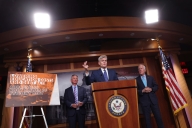You have /5 articles left.
Sign up for a free account or log in.
AUSTIN, TEX. -- As colleges moved into distance education, many questions were raised about how they could serve this new group of students. And colleges responded, with new ideas about online learning resources, academic advising online and so forth.
But what about after distance education takes off? At what point does the question shift from what a college does to offer quality online programs to how a college needs to change in its entirety when it reaches a tipping point in enrollments -- and at what point does such a change take place?
That was the focus of a discussion Monday at the annual meeting here of the National Institute for Staff and Organizational Development, a top meeting of community college faculty members and administrators. The discussion was led by officials from Cerro Coso Community College, a sprawling California district that in the last year saw a majority of its students, any way you count -- 3,500 by headcount, 6,000 by full time enrollment -- become distance students.
"What do we change -- if we change anything?" said Dylan D. Mattina, director of information technology, in introducing the session. "This is something that many institutions will have to deal with at some point."
Mattina and others from his college discussed several of the choices colleges need to make as they reach either 50 percent or some other critical mass where the institution is changed by the success of its distance offerings.
Faculty hiring and training: James Fay, vice president of academic affairs, said that online growth changes the nature of what search committees seek in new hires. While there isn't an expectation that all new hires have distance teaching experience, there needs to be a willingness to learn (including the college's online training program) and to embrace the differences between classroom and online instruction. "A good online class is not just like good classroom-based class," Fay said. "It's not just 'I'm going to move my lecture online,' " he said. When a college offers only some distance offerings, it can rely on those who are enthusiastic. When you reach critical mass, you need buy-in from everyone.
Fay said that he does not force faculty members to teach online, but that as enrollments have shifted, demand has gone down for classroom sections, so that there are fewer of those for professors filling out their schedules.
Karen O'Connor, associate professor of business at the college, said that one shift, as time has gone by, is that more professors realize that online courses are not easy and in fact may impose on their time. So another key factor, she said, is realism. "We need people thinking about how they will plan their time."
Further, she said, faculty members need training on things such as the evolution of cheating techniques online. Students can be savvier than faculty members, so there must be a commitment to keeping current.
O'Connor said that faculty hiring panels on which she sits now routinely ask all candidates about distance education issues -- and that she finds those starting out their academic careers have high familiarity.
Faculty expectations: Mary Retterer, president of the college, noted that every policy the college created over the years assumed that in-classroom instruction was the norm. How should those policies change, she asked, as more faculty time is spent online.
Local ties: Retterer also said she wondered about the long-term impact on community colleges' missions. "Do we continue in this direction or is there a point at which we should say that's enough," she said. The college covers a lot of ground (its service district, in one of California's less populated regions, is larger than Vermont) and the college works hard to help local communities. Now, 17 percent of online students are Californians outside the district, which would have been impossible before distance education. There is also a trickle from outside the state.
Retterer said that, given the reliance on state funds, she's not worried about taking in Californians. But she said she's less certain about the impact from out of state, even with the higher tuition such students pay.
Technology infrastructure: Fay said that as distance enrollments make up a larger share of enrollments, colleges that have let faculty or departments go their own way on course management systems may see the need to centralize. He said that many colleges start distance education piecemeal and programs are set up in different ways. When growth takes place, this makes tech support more expensive and more difficult, he said.
Further, he said that when 50 percent of students are online, the state of tech support becomes one of the most important issues around -- perhaps more important than would have been the case previously. "You can't afford to go down for a day," he said.
Audience members noted their own experiences. One administrator said that now that his college has 20 percent of enrollment online, it is starting to negotiate with its faculty union on changes in procedures so that online teaching is evaluated appropriately and is understood as central to the college's mission. He said that previous contracts haven't touched on the issues much.
Others described tipping points at different divisions of colleges. Julie A. Waskow, chair of philosophy and religion at Glendale Community College, in Arizona, said that her department started small with distance education. But in recent years, enrollment has grown such that half of enrollment is online. The department now has a deputy chair to focus on online issues and has just completed a strategic plan for distance education, looking at how the faculty members will judge success, evaluate courses and build the curriculum.
She urged other departments to do the same, saying that at some point, the growth in enrollments demands that academic units look at where they are headed.




